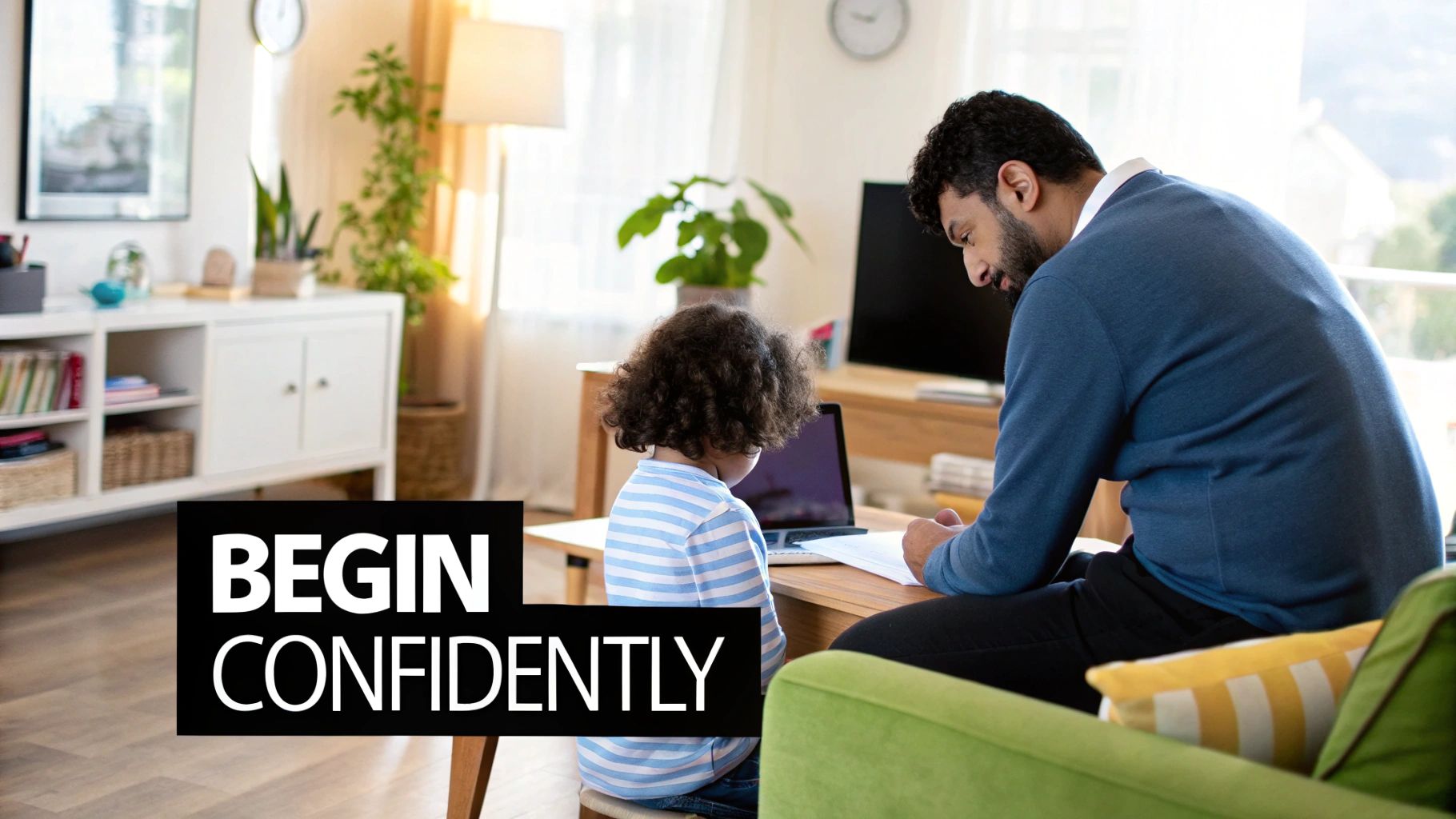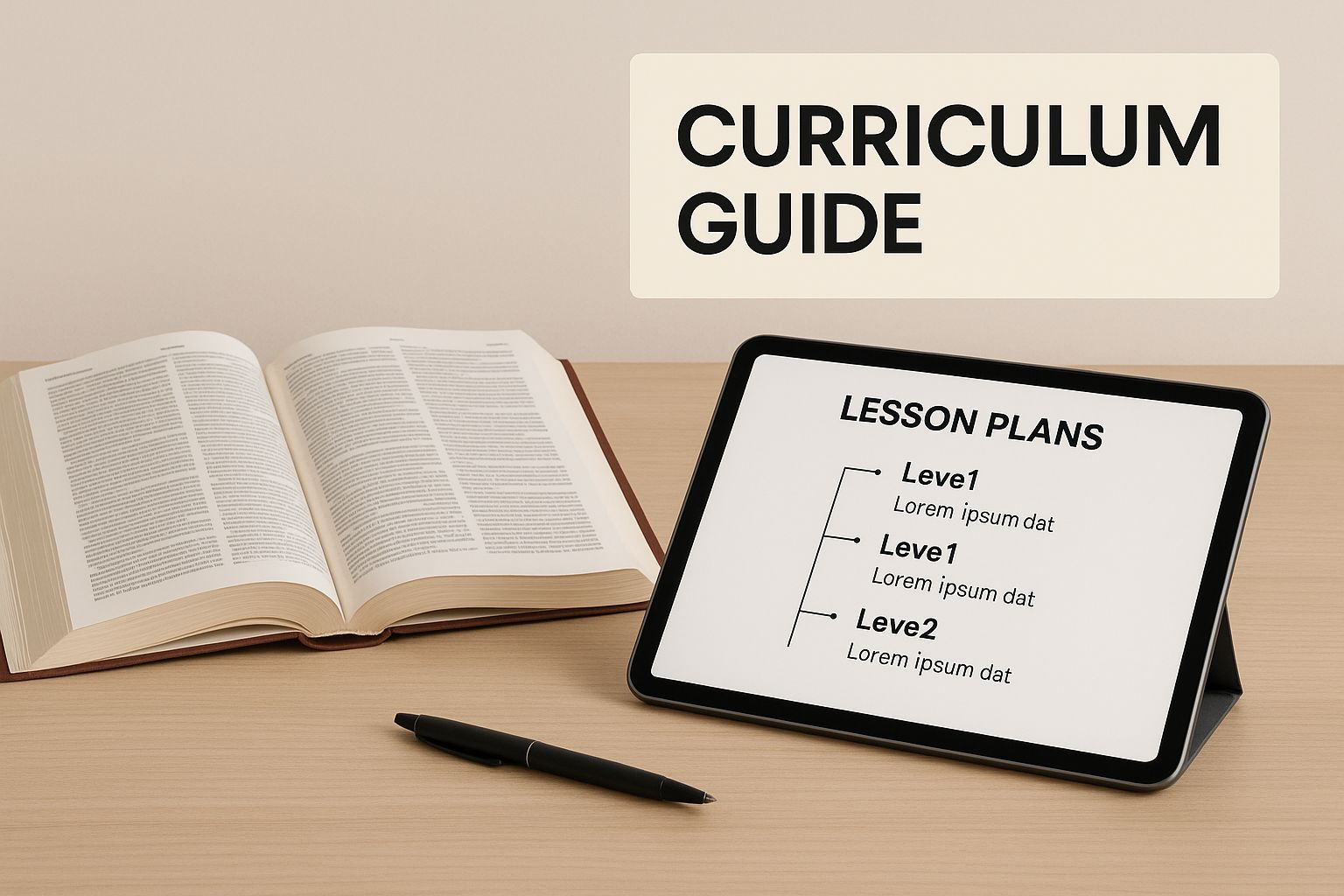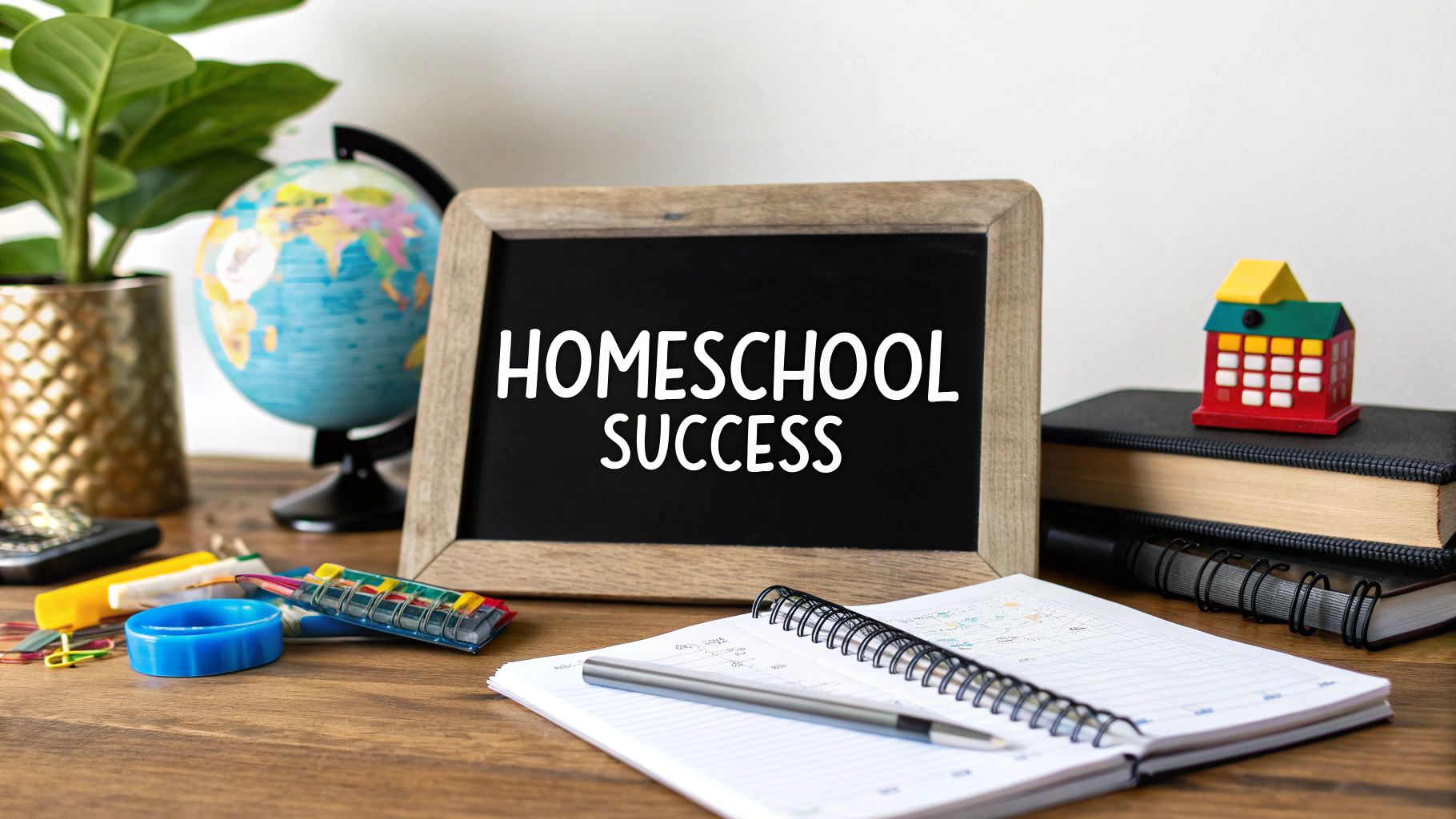Deciding to homeschool your child is one of the biggest, most heartfelt choices you’ll ever make. It’s a path often filled with excitement for the future, but also, let’s be honest, a little bit of anxiety about getting it right. This guide is here to be your reassuring partner, walking you through how to create a homeschooling UK curriculum that puts your child’s passions and well-being at the very centre of everything.
It’s all about building a fulfilling, joyful educational experience, and it’s completely within your grasp.
Starting Your Homeschooling Journey with Confidence

The decision to homeschool often springs from a deep desire to give your child something more—or perhaps something entirely different—from what mainstream schooling can offer. You are absolutely not alone in feeling this way. For countless families, this choice is about crafting a learning adventure that truly honours their child's unique spirit.
This journey is a deeply personal one. Maybe you’re aiming for a more flexible lifestyle that allows for travel and real-world learning. Or perhaps you’re carving out a nurturing, safe space for a child who finds the busy classroom environment overwhelming. Whatever your reason, it’s powerful and valid.
Understanding Your Motivation
Before you dive into lesson plans and resources, take a moment to connect with your "why." This isn't just a logistical exercise; it's an emotional decision rooted in love for your child. Your motivation will be your compass, guiding every choice you make as you explore different educational philosophies and approaches.
Your drive might come from reasons like these:
- Tailoring their education: Does your child have a burning passion for coding, art, or palaeontology that a standard curriculum just can't feed? Homeschooling lets you build lessons around their interests, turning learning from a chore into a joy.
- Supporting their wellbeing: For children who have faced anxiety or bullying, home can be a sanctuary where they can rebuild their confidence and learn without fear.
- Accommodating unique needs: If your child has Special Educational Needs and Disabilities (SEND), you have the freedom to design an environment and a pace that works for them, not against them.
This isn’t just a niche movement anymore; it’s a growing trend reflecting a real shift in what families prioritise. An investigation found a 64% increase in families choosing home education between 2022 and 2023. The key drivers? Lifestyle choices (23%), dissatisfaction with school provisions (13%), and deep concerns over children's mental health (14%). You can read more about what’s behind these numbers in The Lead's analysis of homeschooling statistics.
"The beauty of home education is its flexibility. It’s about letting go of the pressure to replicate a classroom and instead creating an environment where curiosity can flourish naturally."
Ultimately, this is your chance to step away from the rigid world of school bells and strict timetables. You can build a rhythm that respects your child’s natural energy, making education a seamless and enriching part of your family’s life.
A Simple Guide to UK Homeschooling Laws
Let’s be honest, the legal side of homeschooling can feel like the most daunting part of the whole adventure. It’s easy to imagine mountains of paperwork, strict rules, and constant check-ins. But the reality in the UK is refreshingly flexible and, frankly, quite empowering. It’s all built on trusting your judgement and what you know is best for your child.
Your one core legal responsibility is beautifully straightforward: to provide a full-time education that is suitable for your child’s age, ability, and aptitude. So, what does ‘suitable’ actually mean? It certainly doesn’t mean you have to turn your living room into a carbon copy of a school classroom.
What a “Suitable Education” Really Looks Like
A suitable education is simply one that’s a good fit for your child. It meets them where they are right now and gives them what they need to grow. It should feel alive and engaging, not something trapped between the pages of a textbook.
Think of it this way. A suitable education could mean:
- For a child who finds maths stressful: Learning fractions and measurements by baking a cake together. They can feel the ingredients, see the process, and literally taste the results. This makes abstract numbers feel real and rewarding.
- For a budding historian: Getting to grips with the Roman invasion by visiting a local historical site, walking on ancient ground, and then diving into documentaries that make the past feel real.
- For a curious scientist: Exploring physics by building incredible LEGO machines or discovering biology by planting a small garden and watching an ecosystem come to life right outside your window.
The law is designed to give you this freedom. It allows you to create an educational experience that sparks genuine curiosity and helps your child flourish, both emotionally and academically. You’re not alone in choosing this route. Recent government figures show elective home education (EHE) has reached a record high, with 111,700 children now being homeschooled. You can find more details about the rise in home education on the official UK statistics site.
The best way to know if your child’s education is ‘suitable’ is to look at them. If they’re excited, engaged, and growing, you’re getting it right.
How to Work with Your Local Authority
If your child is currently in school, one of your first practical steps will be to de-register them. This is usually just a case of sending a simple letter to the headteacher. We break down exactly how to do this in our guide on how to homeschool in the UK.
Once you've de-registered, the school will inform your Local Authority (LA). It’s crucial to understand that their role is supportive, not prescriptive. They are not there to hand you a homeschooling UK curriculum or tell you how to teach.
The LA’s main job is to make sure that a suitable education is happening. They might get in touch for an informal chat, maybe once a year, just to see how you’re getting on. How you respond is up to you—a written report, a few examples of your child’s work, or a friendly phone call are all perfectly fine. This isn’t an inspection or a test; it’s a conversation to confirm your child is learning. The power to decide what and how your child learns stays firmly with you.
Using the National Curriculum as a Guide, Not a Rulebook
One of the very first questions that comes up for new home educators is a big one: "Do I have to follow the National Curriculum?" The answer is wonderfully, liberatingly simple: no, you don't. For many parents, just hearing that can feel like a huge weight has been lifted from their shoulders.
Let's be honest, the words "National Curriculum" often bring to mind rigid timetables, endless testing, and the constant pressure of keeping pace. But in the world of homeschooling, its role shifts completely. It stops being a strict rulebook and becomes more like a helpful map you can pull out whenever you feel the need.
This is where you get to the heart of creating a homeschooling UK curriculum that’s truly built around your child. You have the freedom to borrow the ideas that work for you, adapt concepts to fit your child's unique way of learning, or even set the whole thing aside when it’s not serving your family. Think of it as a resource, not a restriction.
The infographic below paints a great picture of this shift—moving from a rigid structure to a flexible tool that supports your family's educational path.

This visual captures that change in mindset perfectly. It’s not about following a set path but having a guide that can help you forge your own.
A Benchmark, Not a Blueprint
So, if you’re not required to follow it, why even bother looking at the National Curriculum? Well, it provides a really useful benchmark. Knowing what children in mainstream schools are generally learning at certain ages can give you a bit of confidence and a handy point of reference.
This can be especially reassuring if you think your child might go back to school one day, or if you just want a rough idea of age-appropriate topics. It's a bit like flicking through a travel guide before a big trip. You probably won't follow the suggested itinerary word-for-word, but it’s still good to know where the major landmarks are.
The real power of homeschooling is in the freedom it gives you. You can dive deep into topics your child absolutely adores, explore subjects that aren't even on the curriculum, and focus on genuine understanding over simply ticking boxes.
This freedom allows you to tailor every single day to what your child needs. If they become fascinated by ancient Egypt, you can spend six weeks completely immersed in pyramids, pharaohs, and hieroglyphics—far longer than any school timetable would allow. This is education built on passion, not just on pace.
Understanding the Key Stages
To get the most out of the curriculum as a reference, it helps to understand how it's broken down. The whole thing is organised into 'Key Stages', which are essentially just blocks of school years based on age groups. Knowing these makes it much easier to find relevant resources on sites like BBC Bitesize, which often categorise their content this way.
To give you a clear overview, here’s a quick look at how the stages are laid out in schools.
UK National Curriculum Key Stages at a Glance
This table gives a simple breakdown of the educational stages, the ages they correspond to, and the subjects schools focus on. It's a handy reference point for seeing what's happening in the mainstream system.
| Key Stage | Year Groups | Typical Ages | Core Focus Areas |
|---|---|---|---|
| Early Years (EYFS) | Nursery & Reception | 3 to 5 | Learning through play, early literacy and numeracy, personal and social development. |
| Key Stage 1 (KS1) | Years 1 & 2 | 5 to 7 | Building foundational skills in English (reading, writing) and Mathematics. |
| Key Stage 2 (KS2) | Years 3 to 6 | 7 to 11 | Broadening knowledge in English, Maths, and Science, plus foundation subjects. |
| Key Stage 3 (KS3) | Years 7 to 9 | 11 to 14 | Deepening subject knowledge in preparation for GCSE choices. |
| Key Stage 4 (KS4) | Years 10 & 11 | 14 to 16 | Studying for GCSEs or other national qualifications. |
| Key Stage 5 (Post-16) | Years 12 & 13 | 16 to 18 | Advanced study, typically A-Levels, T-Levels, or other qualifications for higher education. |
Remember, this table is not a timeline your child must stick to. It's just a guide. If your 8-year-old (technically KS2) is working on maths concepts from KS1 but reading books at a KS3 level, that's absolutely fine! You're simply following their unique developmental path, which is the most effective approach of all.
Practical Examples of Curriculum Freedom
Putting all this into practice is where the real magic happens. Let’s say your seven-year-old is endlessly curious about space.
- A school approach might: Dedicate one week to a "Space" topic in science, covering the names of the planets before moving on.
- Your homeschooling approach could: Turn your entire learning for the next month into a cosmic adventure. You could visit a planetarium, build a scale model of the solar system in the garden (Maths), write sci-fi stories about alien worlds (English), and research the history of the Space Race (History).
This is exactly what it means to put your child at the centre of their education. You're not just covering a topic; you're igniting a passion that fosters deep, memorable learning. The curriculum is there to give you ideas, not to limit your imagination or your child's potential.
Designing a Curriculum Around Your Child's Passions

This is where the true heart of home education beats the strongest. Once you've navigated the legal bits and understood the curriculum frameworks, you get to the most joyful part of the journey: building a learning experience that revolves completely around your child.
This isn't about replicating school at the kitchen table. It’s about crafting a homeschooling UK curriculum that feels alive, personal, and deeply meaningful.
The beauty of this approach is that it puts your child's natural curiosity in the driver's seat. When learning is fuelled by genuine interest, it stops feeling like a chore and becomes a thrilling adventure. It’s the difference between being told to learn about something and being unable to stop yourself from finding out more.
Identifying Your Child’s Core Interests
The very first step is observation. What makes your child’s eyes light up? What topics do they return to again and again in conversation or play? Sometimes these passions are loud and obvious, but other times they are quiet whispers you need to listen for carefully.
Crucially, don't dismiss any interest as "not educational enough." Every passion is a doorway to learning.
- The Video Game Enthusiast: Their love for gaming is a goldmine. They can analyse complex narratives (English), manage in-game economies (Maths), study the historical settings of their favourite worlds (History), and even learn basic coding to build their own simple game (IT).
- The Nature Explorer: The back garden or local park becomes a living science lab. They can study plant life cycles (Biology), sketch what they see (Art), write poetry about the seasons (English), and track weather patterns (Geography).
- The Animal Lover: A fascination with animals can lead to researching different habitats (Science), creating fundraising plans for a local shelter (Maths and Citizenship), or writing persuasive letters to support conservation efforts (English).
Your role shifts from teacher to facilitator, connecting their passions to the wider world of knowledge.
Weaving Core Subjects into Everyday Life
One of the biggest anxieties for new homeschooling parents is making sure their child covers the "important" subjects like English and Maths. The good news? These foundational skills are the threads that run through almost every activity. You don’t always need a specific "Maths lesson" when maths is happening all around you.
"True learning isn't confined to a workbook. It happens when a child's mind is engaged, their hands are busy, and their heart is invested in what they are doing."
Think about a simple trip to the supermarket. It’s a real-world lesson in budgeting, calculating discounts, weighing produce, and reading labels. Baking a cake involves fractions, measurements, and following instructions in sequence. Planning a day out uses map-reading, time management, and calculating travel costs.
When you reframe how you see education, you start to realise that learning opportunities are everywhere. This makes knowledge feel relevant and practical, showing your child exactly how these skills are used in the real world.
Finding a Homeschooling Philosophy that Fits
As you start designing your curriculum, you'll come across different names for various approaches. You don't need to subscribe strictly to one, but understanding them can help you find a rhythm that feels right for your family.
- Structured (School-at-Home): This method closely follows a traditional school structure with set timetables and pre-packaged curriculums. It can provide security for families who prefer a clear, predictable plan.
- Charlotte Mason: A gentle, literature-rich approach that focuses on "living books," nature study, art, and music. It values the child as a whole person, not just an academic vessel.
- Unschooling (Interest-Led Learning): This philosophy trusts that children learn what they need to know through their natural life experiences. The child’s interests direct the learning, with the parent acting as a guide.
- Eclectic Homeschooling: By far the most popular approach in the UK. This involves mixing and matching resources, methods, and philosophies to create a completely bespoke education that suits your child's unique needs and your family's lifestyle.
Most families find themselves in the eclectic camp, taking the best bits from different styles. You might have a structured morning for Maths and English, followed by an afternoon of interest-led exploration. Your approach can and should evolve as your child grows.
Practical Strategies for Success
Building a curriculum around passions requires a little creativity and a lot of heart. It's about being a partner in their learning, not just an instructor.
Here are a few practical ways to bring this to life:
- Create a 'Wonder Wall': Dedicate a space—a whiteboard or a big sheet of paper—where your child can post questions about the world. Use these as launchpads for deep dives into new topics.
- Project-Based Learning: Instead of studying subjects in isolation, tackle a big project. "Let's plan a trip to Japan!" can cover geography, history, budgeting, language, and culture all in one exciting, cohesive project.
- Use Technology Wisely: The right tools can open up new worlds. Documentaries bring history to life, and educational apps make practising skills fun. As you tailor the curriculum, you could also explore the benefits of AI text-to-speech for enhancing learning, which can add a dynamic and accessible element to their studies.
Ultimately, designing a curriculum this way sends a powerful message to your child: what you love matters. It shows them that their interests are valid, valuable, and worthy of exploration. This doesn't just create a more effective learner; it nurtures a confident, curious human being who carries a love of learning with them for life.
Finding the Best UK Homeschooling Resources
Stepping into homeschooling doesn’t mean you have to invent every lesson, worksheet, and science experiment from scratch. That thought alone can be overwhelming, but thankfully, there’s a whole world of fantastic resources out there ready to support you and your child. The real art is finding the right blend of tools that fits your child’s learning style, your family’s budget, and the natural rhythm of your home.
Think of yourself as the architect of your child's education, but with a brilliant team of suppliers on hand to provide the materials. From free digital libraries to structured online programmes, there's something to help every family build a vibrant and effective homeschooling experience. The goal is to feel equipped and confident, not burdened by the pressure to be a constant content creator.
Curated Online Curriculum Packages
For families who thrive on structure and love having lessons ready to go, a comprehensive online curriculum package can be a game-changer. These platforms often do the heavy lifting for you, providing everything from video lessons and interactive quizzes to progress tracking, taking a huge amount of planning off your shoulders.
It's worth exploring options that align with the National Curriculum if you want to keep a familiar framework. Many services offer flexible subscriptions, so you can pick and choose subjects or year groups as needed. This kind of structure is especially helpful when you’re just starting out, giving you a safety net while you find your footing. Our guide to UK homeschooling online offers a deeper dive into how these platforms can work for your family.
Free and Low-Cost Educational Tools
Building a rich and engaging curriculum doesn't have to break the bank. In fact, some of the most treasured resources in the UK homeschooling community are completely free. These are perfect for supplementing your core subjects or for diving into a topic your child has suddenly become fascinated with.
A few invaluable free resources include:
- BBC Bitesize: A true staple for UK families. It offers articles, videos, and quizzes perfectly aligned with the National Curriculum’s Key Stages. If your child is studying the Victorians, you’ll find engaging, age-appropriate content in just a few clicks.
- Khan Academy: Famous for its brilliant maths and science content, Khan Academy provides free, world-class education for anyone, anywhere. Its step-by-step video lessons are a lifesaver for visual learners.
- Local Libraries: Never underestimate the power of your local library. Beyond the endless shelves of books, they offer access to computers, workshops, and a quiet space to focus.
As you explore different materials, you might also want to discover how video can serve as a valuable schooling resource, offering another dynamic way to bring topics to life. Financially, this approach is highly sustainable. Most households spend around £500 to £600 per student each year on materials—a stark contrast to private school fees that can easily top £15,000 annually.
The Power of Community Support
Perhaps the most vital resource of all isn't a website or a workbook—it's other people. The emotional and social support you and your child get from connecting with the wider homeschooling community is immeasurable. This is where you’ll find reassurance on tough days and celebrate the small wins with people who truly understand the journey.
"Homeschooling is a journey of shared discovery, not just for your child, but for you. Connecting with others reminds you that you are part of a vibrant, supportive, and incredibly resourceful community."
Look for local homeschooling groups on social media or dedicated websites. These groups often organise regular meetups, park days, museum trips, and even collaborative lessons. For your child, these events provide brilliant opportunities for social interaction and friendship. For you, they offer a network of parents who can share practical tips, resource recommendations, and a much-needed cup of tea. Don't underestimate the feeling of relief that comes from talking to someone who just gets it.
Tracking Progress Without Standardized Tests
How do you know if your child is actually on track? It’s a quiet question that every homeschooling parent asks themselves, usually late at night. The good news is that home education lets you leave the stress of standardised tests behind. Instead, you can embrace more meaningful, human-centred ways of seeing your child’s growth.
This isn’t about ticking boxes on a checklist; it’s about celebrating the journey. Progress isn’t always a straight, measurable line. It’s the spark in their eyes when they finally crack a tricky maths problem, the growing confidence in their voice when they read aloud, or the immense pride they take in a project they’ve poured their heart into.
Celebrating Holistic Growth
The most powerful way to track progress is to truly see your child. This means shifting your focus from test scores to observing their development as a whole person.
Here are a few beautiful and practical ways to do this:
- Create a Portfolio: Think of this less as a formal assessment and more as a treasure chest of their best work. It could hold a beautifully written story, a photo of a complex LEGO build, or a drawing that shows their developing artistic skill.
- Keep a Learning Journal Together: Dedicate a special notebook to jotting down milestones, funny quotes, and those "aha!" moments. Looking back through it together becomes a wonderful way to see just how far they’ve come.
- Have Rich Conversations: Simply talking about what they’re discovering is an incredible tool. Ask open-ended questions like, "What was the most interesting thing you learned today?" Their ability to explain concepts is a true sign of deep understanding.
Progress is watching their skills and confidence blossom through projects, play, and exploration. The goal is to measure growth in a way that builds your child's self-esteem, not their anxiety.
Approaching Formal Qualifications
For families with older children, the question of formal qualifications like GCSEs and A-Levels will eventually come up. It’s entirely possible for homeschooled children to sit for these exams as private candidates.
This involves finding an exam centre that accepts private candidates and registering your child for the specific subjects they wish to take. It definitely requires some forward planning, but it gives your child access to the very same qualifications as their peers in school. You can learn more about the different methods for evaluating learning in our guide to assessment for education.
Ultimately, tracking progress is about knowing your child. When you’re their dedicated guide, you’re in the perfect position to see every small step forward. This approach, built on connection and observation, fosters a love of learning that will last a lifetime.
Got Questions About Homeschooling in the UK? Let's Talk.
Stepping into the world of homeschooling always brings a flurry of questions. It's totally normal to feel a mix of excitement and "can I really do this?" uncertainty. Let's tackle some of the most common worries head-on, so you can feel more confident about the path ahead.
The biggest question is often a deeply personal one: "Am I qualified enough to teach my own child?" The answer is a wholehearted yes. You don't need a teaching degree or any formal qualifications to homeschool in the UK. Your most powerful tool is something no teacher will ever have: your deep, intuitive understanding of your child—their quirks, their passions, their sticking points. The only legal requirement is that you provide an education suitable for their age, ability, and unique needs.
What About Their Social Life?
Right after the "am I qualified?" question comes the worry about socialisation. It’s a classic, but one worth addressing properly. Will my child miss out on making friends? The reality is, homeschooling doesn't mean less social interaction; it just means a different, often richer, kind. It breaks them out of the classroom bubble where they only mix with kids born in the same year.
Instead, their social life can flourish in more natural ways:
- Local Homeschool Groups: These are absolute goldmines. Think park meet-ups, group lessons on everything from art to science, and field trips. They're fantastic hubs for kids (and parents!) to build lasting friendships.
- Community Activities: Signing up for sports clubs, drama groups, Scouts, or even volunteering lets your child connect with a whole range of people, young and old, who share their genuine interests.
This approach helps children build the confidence to chat with anyone, anywhere—a vital skill for life, not just for the playground.
"Socialisation isn't about the number of children they see each day, but the quality of the connections they make. Homeschooling creates space for deep, meaningful relationships to form naturally."
And finally, the big "what if": what if you change your mind? It's simple. You can apply for a school place at any point. The school will work with you and your child to find the right year group for them. Keeping a simple portfolio of their work—a few photos, some favourite projects—can make that transition feel much smoother and beautifully showcases their unique learning journey. It’s all about flexibility and doing what’s right for your child, every step of the way.
At Queens Online School, we understand that every family's educational journey is different. We offer a supportive, structured online environment that follows the British curriculum, allowing your child to thrive from the comfort of home. Discover how our live, interactive classes and dedicated teachers can support your family by visiting us at https://queensonlineschool.com.

